Parking area lighting design is a critical aspect of creating safe and efficient spaces for vehicles and pedestrians. At PacLights, we understand the importance of balancing safety, energy efficiency, and aesthetics in illuminating these areas.
This blog post will explore key factors to consider, fixture selection tips, and effective layout strategies for optimal parking lot lighting. We’ll also discuss how to comply with regulations while minimizing light pollution and maximizing cost-effectiveness.
What Makes Effective Parking Area Lighting?
Effective parking area lighting balances multiple factors to create a safe environment while considering energy consumption and local regulations. This chapter explores the key elements that contribute to a well-designed parking area lighting system.
Safety and Security: The Top Priority
Safety stands as the cornerstone of parking area design. The Illuminating Engineering Society (IES) sets specific recommendations for illuminance levels, with a footcandle being equal to one lumen per square foot.
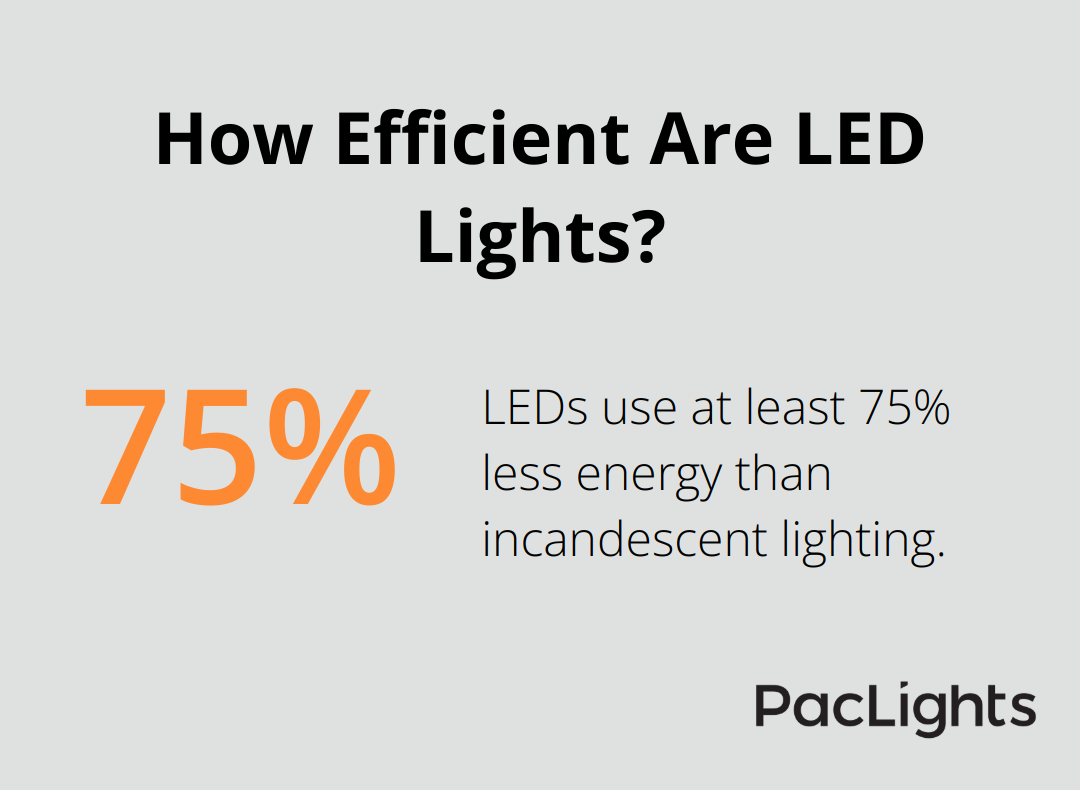
These levels allow drivers to navigate safely and pedestrians to move with confidence. Proper positioning and height of lights are crucial for effective illumination in a parking lot.
Energy Efficiency: A Smart Investment
Energy efficiency represents responsible resource management and cost savings. LED lighting has become the preferred choice for parking areas due to its longevity and low energy consumption. The Department of Energy reports that LEDs use at least 75% less energy and last 25 times longer than incandescent lighting. This translates to substantial cost reductions over time.
Uniform Coverage: Eliminating Dark Spots
Uniform lighting eliminates dark spots and shadows where accidents or criminal activity could occur. Try to achieve a uniformity ratio of:
- 20:1 for typical conditions
- 15:1 for enhanced security
This means the brightest area should not exceed 20 times (or 15 times for high-security areas) the brightness of the darkest area. Effective design will assist in establishing a consistent aesthetic and help create a welcoming atmosphere.
Light Pollution Reduction: A Growing Concern
Light pollution has become a significant issue in urban areas. To address this, select fixtures with full cut-off or sharp cut-off designs that direct light downward (where it’s needed) rather than up into the sky or onto neighboring properties. The International Dark-Sky Association provides guidelines for responsible outdoor lighting that reduces light pollution while maintaining safety.
Compliance with Local Regulations: A Must
Local regulations can vary widely, so research and comply with your area’s specific requirements. These may include restrictions on:
- Light trespass
- Maximum illuminance levels
- Color temperature of lights
Many municipalities now require dark sky compliance to reduce light pollution.
The next chapter will focus on choosing the right fixtures for parking areas, a critical step in implementing an effective lighting design.
Selecting Optimal Fixtures for Parking Areas
LED Technology: The Superior Choice
LED technology has transformed outdoor lighting, offering unparalleled advantages for parking areas. The U.S. Department of Energy reports that LEDs consume at least 75% less energy and last up to 25 times longer than incandescent lighting. This translates to significant energy savings and reduced maintenance costs over time.
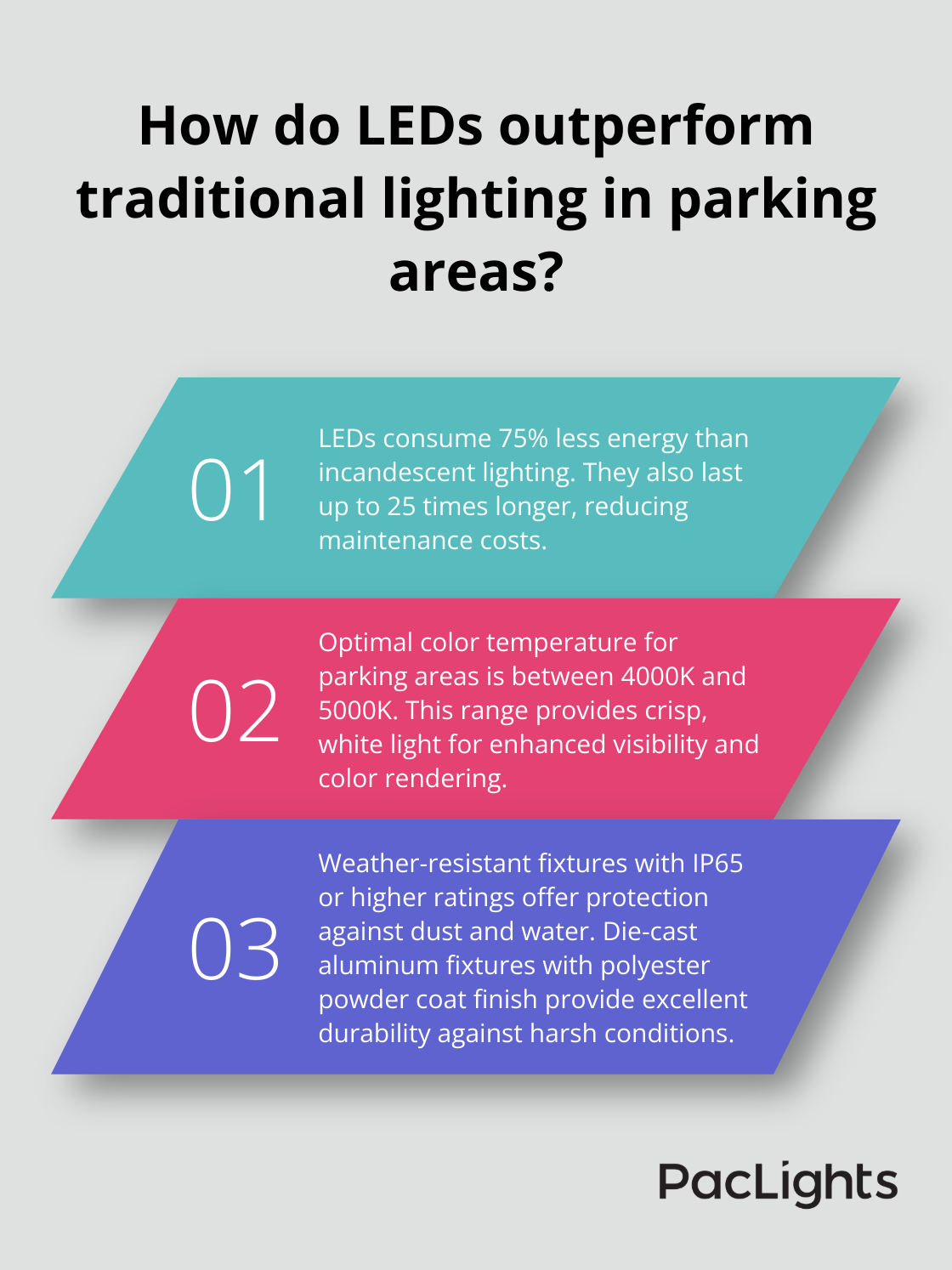
For parking areas, fixtures with a color temperature between 4000K and 5000K provide the best results. This range offers a crisp, white light that enhances visibility and color rendering (essential for security cameras and accurate vehicle identification).
Weather-Resistant Fixtures for Durability
Parking area lights must withstand harsh environmental conditions. Fixtures with an Ingress Protection (IP) rating of at least IP65 ensure protection against dust and water jets. For coastal areas or regions with extreme weather, IP66 or higher-rated fixtures offer superior protection.
Die-cast aluminum fixtures with a polyester powder coat finish provide excellent durability. These materials resist UV radiation, salt spray, and temperature fluctuations, ensuring a long-lasting lighting investment.
Optimal Mounting and Height
The mounting height of fixtures plays a key role in light distribution and glare reduction. Small parking lots typically require poles between 15-20 feet, while larger areas may need poles up to 30-40 feet tall for optimal coverage.
Adjustable arm mounts or slip fitter mounts offer flexibility in aiming the light. This allows for post-installation fine-tuning of light distribution, ensuring uniform coverage and minimizing dark spots.
Smart Lighting Capabilities
Smart lighting capabilities significantly enhance the efficiency and functionality of parking area illumination. Networked lighting controls enable remote monitoring, scheduling, and dimming based on occupancy or time of day.
Motion sensors can cut energy consumption by up to 30% by dimming lights in unoccupied areas. Photocells ensure lights operate only when natural light levels are insufficient, further optimizing energy use.
Some advanced systems integrate with parking management software, using lighting to guide drivers to available spaces (reducing congestion and improving the overall parking experience).
The next chapter will explore effective lighting layout strategies to maximize coverage and safety in parking areas.
How to Optimize Parking Area Lighting Layout
Strategic Pole Placement
The foundation of an effective lighting layout rests on strategic pole placement. Space the poles about 20 feet apart. This is the average lighting. However, with different parking lots, you can determine the number of lights needed based on the specific characteristics of the area.
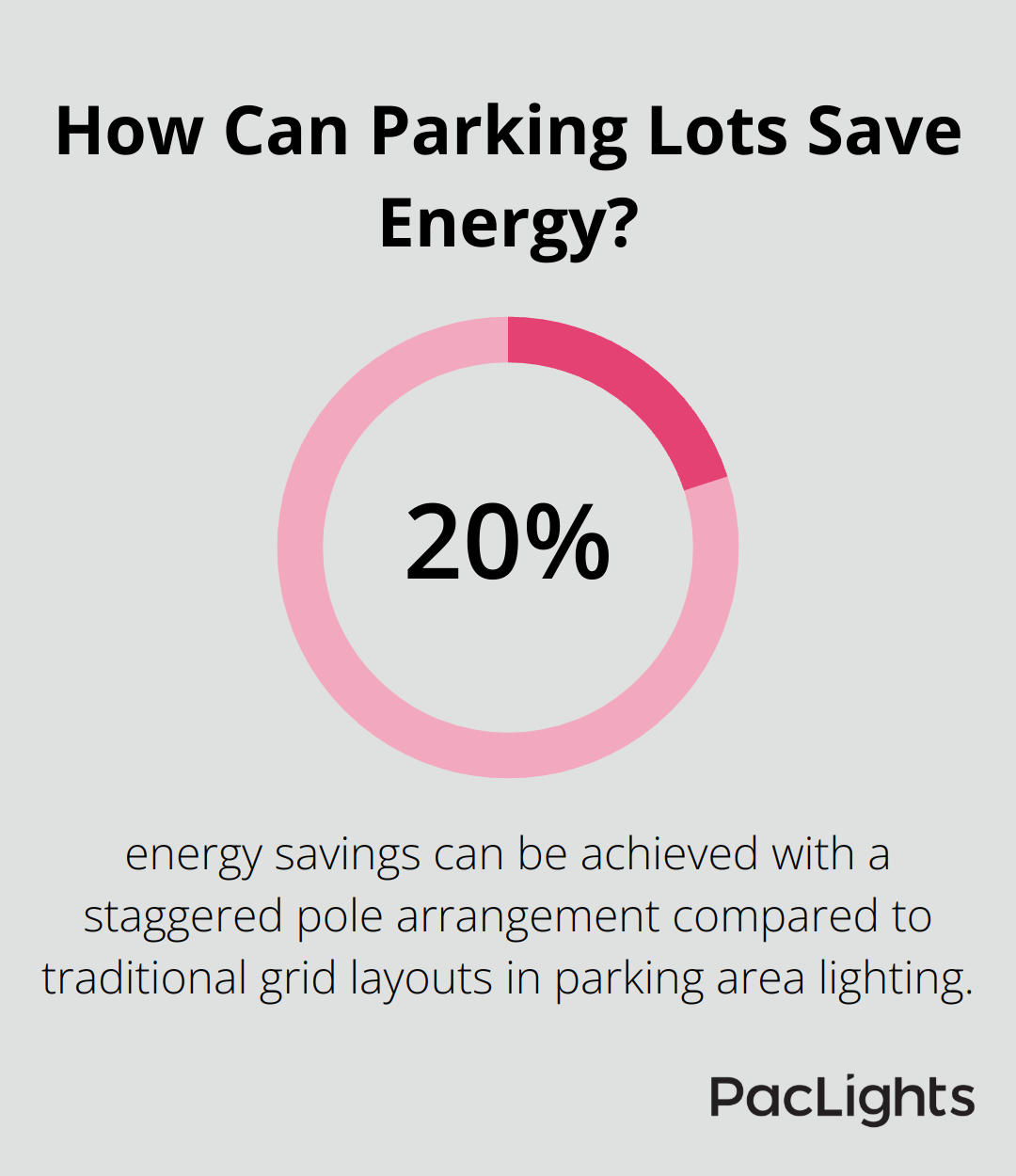
Larger parking areas often benefit from a staggered pole arrangement rather than a grid pattern. This approach reduces the number of poles needed while maintaining consistent illumination. Energy savings of up to 20% (compared to traditional grid layouts) can be achieved with this strategy.
Tailoring Light Distribution
Light distribution patterns play a vital role in achieving uniform illumination. Type V distribution (which provides a circular pattern) works well for open areas. Type III distribution (offering an oval pattern) is ideal for perimeter lighting and narrow parking aisles.
For optimal results, combine different distribution types. Use Type V fixtures in the center of the parking area and Type III along the edges. This combination ensures comprehensive coverage and reduces light trespass onto neighboring properties.
Eliminating Dark Spots
Dark spots in parking areas pose significant safety risks. To address this issue, focus on potential problem areas such as corners, alcoves, and areas near vegetation. The National Institute of Justice recommends a minimum illuminance of 0.5 foot-candles throughout the parking area to deter criminal activity.
Wall-mounted fixtures can supplement pole-mounted lights in these challenging areas. This approach not only eliminates dark spots but also enhances the overall aesthetic appeal of the parking facility.
Pedestrian-Friendly Illumination
Pedestrian safety demands special attention in parking area lighting design. The Federal Highway Administration suggests a minimum of 1 foot-candle for walkways and 2 foot-candles at crossings. Lower-height poles (12-15 feet) along walkways provide focused illumination without causing glare.
For entrances and exits, increase light levels gradually to allow eyes to adjust. This transition zone should extend approximately 15 feet into the parking area, helping to reduce accidents as drivers enter or exit the facility.
Adapting to Unique Characteristics
Each parking facility has unique characteristics that require tailored lighting solutions. Consider factors such as:
- The shape and size of the parking area
- Surrounding buildings and structures
- Local regulations and light pollution concerns
- Traffic flow patterns
Try to create a lighting plan that addresses these specific needs while maintaining overall safety and efficiency standards.
Final Thoughts
Effective parking area lighting design balances safety, efficiency, and aesthetics to create welcoming and secure environments. Facility managers can enhance user experience and minimize operational costs through careful consideration of uniformity, energy efficiency, and light pollution reduction. The selection of appropriate fixtures, such as LED technology and smart lighting capabilities, provides superior performance and adaptability for long-term success.
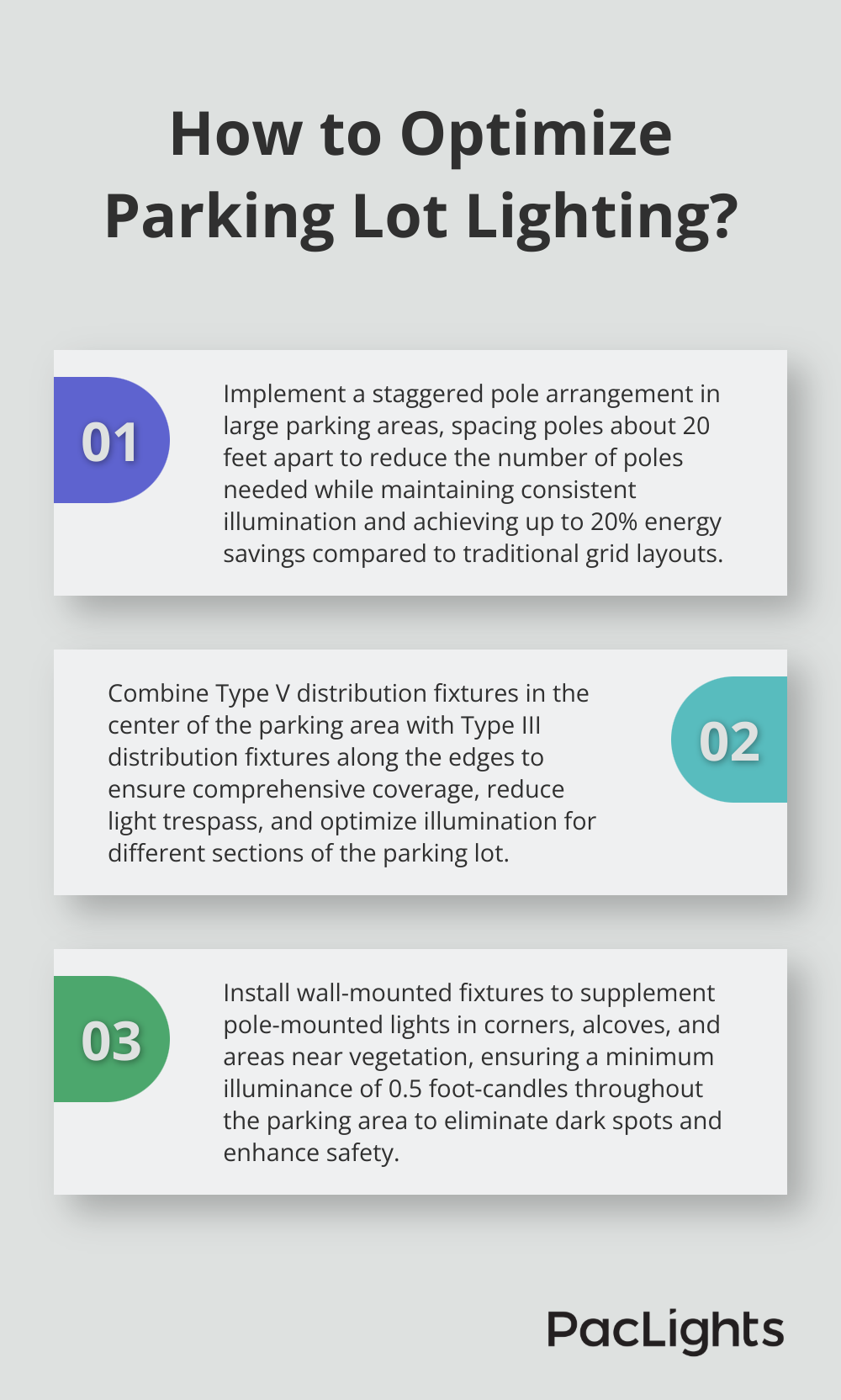
Strategic layout planning maximizes coverage and eliminates dark spots, addressing unique challenges in each parking facility. Professional lighting design services play a vital role in navigating complex regulations, optimizing layouts, and ensuring compliance with local ordinances. These experts prevent costly mistakes and maximize the return on investment for lighting projects.
PacLights specializes in providing comprehensive parking area lighting solutions. Our range of energy-efficient fixtures and advanced control options allows us to create tailored lighting designs that meet the unique needs of each facility. We strive to deliver lighting solutions that enhance safety, reduce costs, and create inviting spaces for years to come.


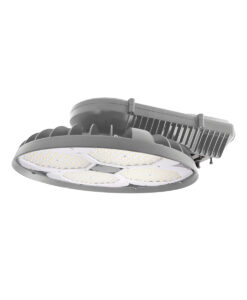
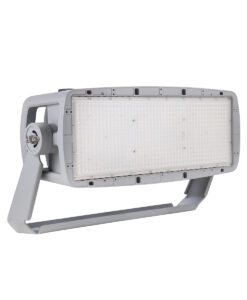

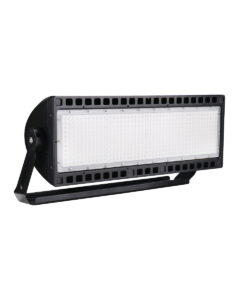
Disclaimer: PacLights is not responsible for any actions taken based on the suggestions and information provided in this article, and readers should consult local building and electrical codes for proper guidance.